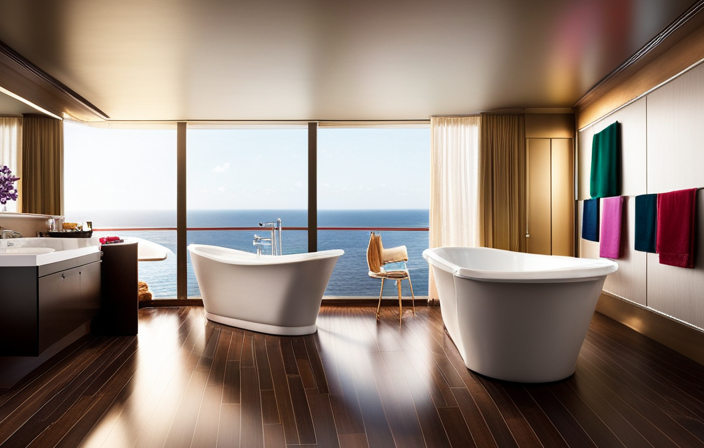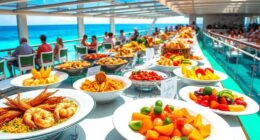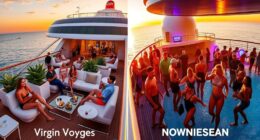Hello! Have you ever pondered how cruise ships maintain their balance and prevent capsizing in the vast, unpredictable ocean waters? Have no fear, as I am here to uncover this captivating maritime enigma for you. In this article, we will delve into the mesmerizing realm of ship buoyancy and examine the factors that ensure these immense ships remain afloat.
First and foremost, let’s talk about buoyancy. It’s the force that allows objects to float in water by exerting an upward pressure equal to the weight of the fluid displaced. Cruise ships are carefully designed with a shape that maximizes buoyancy, enabling them to effortlessly glide through waves.
Weight distribution is another crucial aspect. These behemoths are meticulously built with heavy machinery and materials placed strategically throughout their structure. This ensures balance and prevents any unwanted tilting during sailing.
But it doesn’t end there! The impact of wind and waves can pose challenges too. Fortunately, advanced navigation systems help ships navigate through rough seas while maintaining stability.
So buckle up as we embark on an enlightening journey through ship stability. By understanding these principles, you’ll gain a newfound appreciation for these incredible vessels that gracefully sail across our oceans.
Key Takeaways
- Cruise ships are designed with ship stability in mind, using strategies such as balancing weight distribution and lowering the center of gravity.
- Ballast tanks play a crucial role in stability control, allowing for adjustments to the ship’s center of gravity by filling or emptying the tanks with water.
- Advanced navigation systems equipped with GPS, radar, sonar, and other instruments ensure safe navigation by providing accurate positioning information and detecting potential hazards.
- Safety regulations and inspections, along with crew training and emergency procedures, work together to minimize risks and ensure passenger safety, with regular stability drills and exercises being conducted.
The Basics of Ship Stability
Cruise ships maintain balance and stability through the careful distribution of weight and buoyancy. The center of gravity is a crucial factor in this process as it represents the point where the ship’s weight is concentrated. By placing heavy items like engines and fuel tanks low in the ship, the center of gravity remains low, ensuring stability and preventing tipping over.
Cargo placement also plays a significant role in ship stability. When cargo is evenly distributed throughout the ship, it helps maintain an optimal balance between its sides. However, unevenly distributing cargo can create an imbalance that may lead to listing or even capsizing.
Now, let’s move on to discussing the role of buoyancy in keeping cruise ships afloat.
The Role of Buoyancy
One fascinating theory suggests that the buoyancy of these massive vessels plays a crucial role in maintaining their stability. The role of displacement, or the weight of water displaced by the ship’s hull, is central to this theory.
When a cruise ship is floating in water, it displaces an amount of water equal to its own weight. This displacement creates an upward force known as buoyancy, which counteracts the downward force exerted by gravity on the ship. The buoyant force helps keep the ship afloat and prevents it from tipping over.
Another factor that affects a cruise ship’s stability is the impact of cargo. Depending on how cargo is distributed throughout the ship, it can affect its center of gravity and therefore its stability. Proper distribution of cargo is essential for maintaining equilibrium and preventing any potential tipping motions.
Understanding how buoyancy and cargo impact stability allows engineers to design cruise ships that are both safe and stable on the open seas. These considerations play an important role in determining various aspects of a ship’s design, such as its hull shape and size, as well as its internal layout and distribution of compartments.
The Design of Cruise Ships
Imagine yourself on a magnificent cruise liner, where the design of the ship ensures stability and safety as you sail through the open seas. The architecture of cruise ships is meticulously planned to withstand the forces of nature that they encounter.
Structural integrity is paramount in their construction, with strong materials like steel used for the hull and superstructure. The ship’s design includes multiple decks and compartments that are strategically placed to distribute weight evenly throughout the vessel. This helps maintain balance and prevents tipping over even in rough waters or during unexpected maneuvers.
Additionally, cruise ships have stabilizers built into their structure, which can be extended to counteract rolling motions caused by waves. These features combined create a robust and secure platform for passengers to enjoy their voyage.
Transitioning into the subsequent section about ‘the importance of weight distribution,’ it is crucial to understand how this aspect further contributes to a ship’s stability at sea without compromising its comfort or luxury.
The Importance of Weight Distribution
The weight distribution of a cruise ship is crucial for maintaining stability and preventing any wobbling at sea. There are three key factors to consider when understanding the importance of weight distribution.
-
Center of Gravity: The ship’s center of gravity must be carefully calculated to maintain equilibrium. Any significant shift in weight can disrupt this balance and potentially lead to tipping over.
-
Cargo Weight: The distribution of cargo throughout the ship plays a crucial role in maintaining stability. Unevenly distributed cargo can create imbalances that affect the ship’s overall performance.
-
Ballast Tanks: Strategically placed ballast tanks help adjust the ship’s weight distribution, counteracting any changes caused by loading or unloading cargo.
Proper weight distribution is essential for cruise ships to remain stable and safe on the water. However, it is not the only factor that affects their stability. The impact of wind and waves also needs to be considered to ensure smooth sailing without compromising safety.
The Impact of Wind and Waves
When it comes to understanding the impact of wind and waves on cruise ships, two key points come to mind:
-
Wave resistance and ship design: Wave resistance refers to the force that is exerted on a ship as it moves through water, which can significantly affect its speed and stability. Ship design plays a crucial role in minimizing wave resistance by incorporating features such as hull shape and length-to-beam ratio.
-
Wind forces and sail area: Wind forces can pose a challenge due to their potential to create unstable conditions for the ship. Sail area, which refers to the total surface area of all sails, determines how much wind force can be harnessed for propulsion while also considering factors like stability and safety.
Wave Resistance and Ship Design
Cruise ships stay upright due to their carefully designed hulls and the way they resist waves. Wave resistance is a crucial aspect of ship design, as it helps counteract the forces exerted by waves. To achieve this, hydrodynamics theory is employed to minimize the impact of wave dynamics on the ship’s stability.
Here are some key factors that contribute to wave resistance:
-
Hull shape: Cruise ships are built with a specific hull shape that allows them to navigate through water efficiently while minimizing the effect of waves.
-
Buoyancy: The ship’s buoyancy plays a significant role in keeping it stable. By displacing an amount of water equal to its weight, the ship can maintain its position even when subjected to wave forces.
-
Stability systems: Modern cruise ships utilize advanced stabilizer systems that actively counteract rolling motions caused by waves, further enhancing their stability.
-
Structural integrity: The ship’s robust construction ensures its ability to withstand wave impacts and maintain its structural integrity.
Transitioning into wind forces and sail area, these factors also influence a cruise ship’s stability at sea without compromising safety and comfort.
Wind Forces and Sail Area
When it comes to ship stability, wind forces play a crucial role. The sail area of a ship is directly related to the amount of force exerted by the wind. A larger sail area means more force acting on the ship, which can result in instability if not properly balanced.
To counteract this, cruise ships are designed with careful consideration given to their sail area and the distribution of weight throughout the vessel. By strategically placing heavy items low in the ship’s hull, such as fuel tanks or ballast tanks, the center of gravity is lowered, increasing stability. This allows cruise ships to withstand strong winds without tipping over.
In summary, wind forces and sail area are important factors in ship stability. The sail area determines the force exerted by the wind, and cruise ships are designed to balance this force through careful weight distribution. By lowering the center of gravity, cruise ships can remain stable even in the face of strong winds.
The Role of Ballast Tanks
The role of ballast tanks in the stability control systems of a cruise ship is crucial. To ensure stability, these tanks are strategically placed throughout the ship’s hull and can be filled or emptied with water to adjust the ship’s center of gravity. By doing so, they counterbalance external forces such as wind and waves, keeping the ship upright even in rough seas.
The amount of water in each tank is carefully calculated based on factors like weather conditions and passenger load. Modern cruise ships also utilize advanced navigation systems that work in tandem with the ballast tanks to further enhance stability and ensure a smooth voyage for passengers.
With these sophisticated systems in place, your cruise ship remains steadfast even in challenging maritime environments without compromising comfort or safety.
Advanced Navigation Systems
In my previous section, I discussed the important role of ballast tanks in maintaining stability on cruise ships.
Now, let’s delve into another crucial aspect that prevents these massive vessels from tipping over: advanced navigation systems.
Cruise ships are equipped with state-of-the-art technology that ensures safe and precise navigation even in challenging conditions. These advanced systems rely on a combination of GPS, radar, sonar, and other instruments to provide accurate positioning information and detect potential hazards such as reefs or shallow waters.
Additionally, these navigation systems constantly monitor weather conditions like wind speed, wave height, and current strength to make real-time adjustments to the ship’s course if necessary.
By utilizing this advanced navigation technology and accounting for the impact of weather conditions, cruise ships maintain their stability throughout their journeys.
As we move forward into the next section about safety regulations and inspections, it is important to note that these sophisticated navigation systems play a vital role in ensuring compliance with industry standards.
Safety Regulations and Inspections
Laws and inspections help ensure that cruise ships maintain safety standards throughout their journeys. Safety regulations are put in place to minimize risks and protect passengers and crew members from potential hazards. Inspections are carried out regularly to assess compliance with these regulations and identify any areas that require improvement.
To paint a picture of the inspection process, here is a 3 item numeric list:
- Structural Integrity: Inspectors thoroughly examine the ship’s hull, machinery, electrical systems, and other critical components to ensure they meet safety standards.
- Emergency Equipment: The presence and functionality of lifeboats, life jackets, fire suppression systems, and emergency communication devices are carefully inspected.
- Operational Procedures: Inspectors review the ship’s operational procedures for navigation, evacuation drills, emergency response protocols, and crew training programs.
These inspections aim to identify any deficiencies or non-compliance with safety regulations. This ensures that cruise ships are well-prepared to handle emergencies effectively.
With thorough inspections completed, the focus now shifts towards crew training and emergency procedures.
Crew Training and Emergency Procedures
During my research, I’ve discovered that crew training and emergency procedures are crucial components of ensuring the safety of a cruise ship. One important aspect is stability drills and exercises. These involve simulating various scenarios to prepare the crew for stabilizing the ship during challenging conditions.
Additionally, emergency response and evacuation plans are meticulously designed. These plans are created to guide the crew in swiftly responding to any crisis situation and effectively evacuating passengers if necessary.
These measures play a key role in maintaining the stability and safety of cruise ships at all times.
Stability Drills and Exercises
Stability drills and exercises help cruise ships maintain their balance, preventing them from tipping over like a tightrope walker gracefully gliding above the ground. These drills are crucial for ensuring the ship’s stability during various scenarios, such as extreme weather conditions or sudden shifts in weight distribution. One way to assess stability is through stability testing, where the ship’s response to different conditions is measured. This involves simulating various situations, such as tilting the ship to one side or adding weight unevenly. By analyzing the results of these simulations, engineers can determine if any adjustments need to be made to improve stability. Additionally, crew members participate in regular stability exercises that familiarize them with emergency procedures and equip them with the skills necessary for maintaining balance during critical situations. As we delve into emergency response and evacuation plans, it becomes evident how these drills intertwine with ensuring passenger safety seamlessly
Emergency Response and Evacuation Plans
In case of emergencies, cruise ship crews have detailed plans in place for quickly responding and safely evacuating passengers. Emergency response is a critical aspect of ensuring the safety of everyone on board.
These plans include specific procedures for different types of emergencies, such as fires, collisions, or severe weather conditions. Crew members are trained to handle these situations efficiently and effectively.
Evacuation plans outline the process of safely getting passengers off the ship and onto lifeboats or other rescue vessels. This includes designated assembly points, evacuation routes, and instructions for passengers to follow. The goal is to ensure that everyone can be evacuated in a timely manner while minimizing panic and confusion.
Looking ahead, future trends in ship stability will continue to prioritize emergency response and evacuation plans as key components of passenger safety.
NEXT SUBTOPIC: ‘Future Trends in Ship Stability’
Future Trends in Ship Stability
Future trends in ship stability are important to consider when addressing how cruise ships do not tip over. The maritime industry is constantly evolving, and there are several key areas where advancements and technology integration can enhance ship stability.
One such area is the development of advanced stabilization systems. These systems utilize cutting-edge sensors and algorithms to actively counteract external forces that could potentially cause a ship to tip over. By continuously monitoring the vessel’s motion, these systems can automatically adjust ballast or deploy stabilizer fins to maintain equilibrium.
Improvements in hull design also play a significant role in ship stability. The use of lightweight materials and innovative shapes can contribute to better stability performance. These advancements in hull design help to distribute weight more efficiently and reduce the risk of tipping.
Ongoing research into hydrodynamics and computational fluid dynamics is another area that is contributing to future trends in ship stability. By studying the behavior of ships in different sea conditions and using advanced simulations and predictions, designers can make more accurate assessments of a ship’s stability.
By incorporating these future trends in ship stability, cruise ships can continue to ensure safe and comfortable journeys for passengers. These advancements in stabilization systems, hull design, and research into hydrodynamics will play a vital role in maintaining the stability of cruise ships in the years to come.
Frequently Asked Questions
How do cruise ships handle extreme weather conditions like hurricanes?
During extreme weather conditions like hurricanes, cruise ships have emergency evacuation procedures in place. These include directing passengers to designated safe areas and instructing them on how to safely disembark if necessary. Additionally, the itineraries of cruise ships may be altered to avoid areas with severe weather conditions.
What measures are taken to prevent capsizing in rough seas?
In order to prevent capsizing in rough seas, cruise ships are equipped with advanced stabilizing technologies. These include wave resistance systems and sophisticated ballast control mechanisms to counteract the forces of the waves and maintain stability.
How are cruise ships designed to handle uneven weight distribution caused by passengers’ movements?
Cruise ships ensure passenger safety and maintain structural integrity by incorporating multiple design features. These include a wide beam, low center of gravity, stabilizers, ballast tanks, and advanced computer systems to monitor weight distribution and adjust accordingly.
Are there any safety features in place to prevent cruise ships from tipping over due to mechanical failures?
To ensure stability, cruise ships incorporate numerous safety features that mitigate the risk of tipping over due to mechanical failures. These include advanced stabilizer systems, redundant propulsion systems, and sophisticated monitoring and control mechanisms.
How do cruise ships maintain stability while accommodating large crowds of passengers?
To maintain stability while accommodating large crowds of passengers, cruise ships utilize various stability mechanisms such as ballast tanks, stabilizers, and a low center of gravity. Crowd management techniques include designated areas, passenger flow planning, and emergency drills.
Conclusion
In conclusion, the stability of cruise ships is a complex and meticulously engineered process. The careful design, weight distribution, and advanced navigation systems all work together to ensure that these massive vessels remain upright in even the most challenging conditions.
Safety regulations and crew training further enhance the ship’s ability to withstand external forces.
But as we marvel at their remarkable stability, let us ask ourselves: How do these colossal structures defy gravity and stay afloat amidst the vastness of the ocean?










